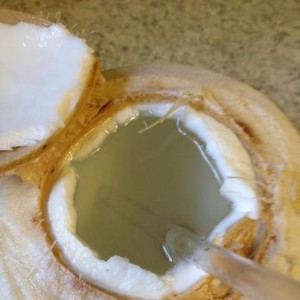 I love young Thai coconuts! You probably do too and that’s why you’re here. You’re wondering about the chemicals coconuts are sprayed and soaked in, right?
I love young Thai coconuts! You probably do too and that’s why you’re here. You’re wondering about the chemicals coconuts are sprayed and soaked in, right?
Treatment
After the outer green husk of the young coconut is removed, the young Thai coconuts are soaked for 2 to 5 minutes in solution mixed with sodium metabisulfite, which is used in preserving foods and wine making. It is also used as a bleaching agent in paper and textile industries. Some people may be allergic to this. It can cause respiratory problems including shortening of breathe, wheezing, coughing and skin reactions. Without this post harvest treatment, the fiber of the coconut would turn reddish brown after husking. The fiber is also prone to fungus and mold. The coconuts would look very unappealing and most of us would not want to buy it. After they are dried, the coconuts are wrapped in plastic and sent away to survive the long journey to stores and farms around the world.
They are safe!
Matt Amsden, of RAWvolution, had his coconuts tested a Michelson Laboratories, an accredited microbiology and chemical testing lab in Commerce, California. The results came back and showed that his Thai coconuts were never in contact with formaldehyde.
There is an article on the internet that shows a coconut that was soaked 3 hours in dye and it did not penetrate the shell. The coconut shell is a very strong barrier which keeps anything from penetrating into the juice and the meat. See the sources below for the report.
A publication by the Journal of Chromatography A revealed that two methods were used to determine 11 pesticides in coconut water. Limits of detection ranged from 0.002 to 2.0 mg/kg. The analytical procedures were applied to 15 samples and no detectable amounts of the pesticides were found in any samples under the conditions described.
Tips
- Use your knife to cut away the husk around the top area to make it easier to cut into the shell. Then use the heel of the knife to hit it once hard. You can then pry the coconut open and pull the top off as pictured above.
- Always wash your hands well after handling the raw coconuts.
- Be sure to scoop the inside out and get the meat. It’s the best part!
- If a coconut has a slight pink color on the inside, it means it has been exposed to heat. It is unclear whether this happens while on the tree or during transport. There are some bottled coconut water companies that claim it is naturally occurring. There’s uncertainty about the safeness of eating and drinking young Thai coconuts that have turned pink.
- When selecting young Thai coconuts always look closely at the bottom. Choose coconuts that are uniformly smooth and don’t have any signs of pinking or other discoloration.
Vitamins, amino acids and minerals
- Coconut water contains potassium, calcium, magnesium, manganese, phosphorous, sodium, iron and copper. It is rich in essential amino acids such as lysine, cystine, leucine, phenylalanine, tryptophan and histidine. The levels of arginine, cysteine, alanine, and serine is higher than those of cow’s milk. Coconut water also contains B complex vitamins and ascorbic acid.
- Coconut water is called the “Fluid of Life.”
- During the WWII in the Pacific, coconut water was siphoned directly from the coconuts to wounded soldiers for emergency plasma transfusions.
- It helps to dissolves kidney stones by flushing the stones faster.
- Reduces urinary tract infections.
- Boosts metabolism and controls weight.
